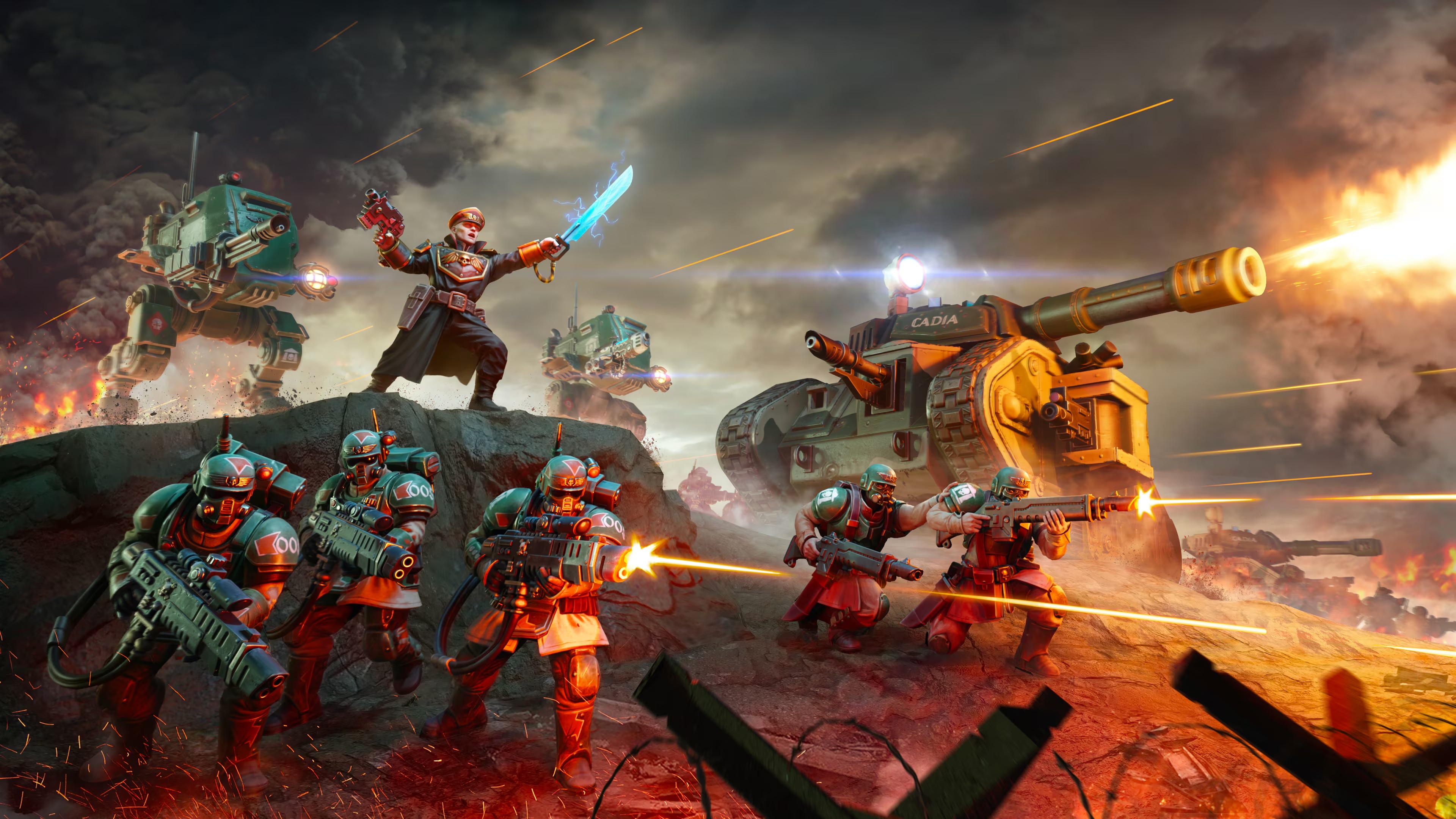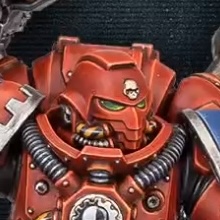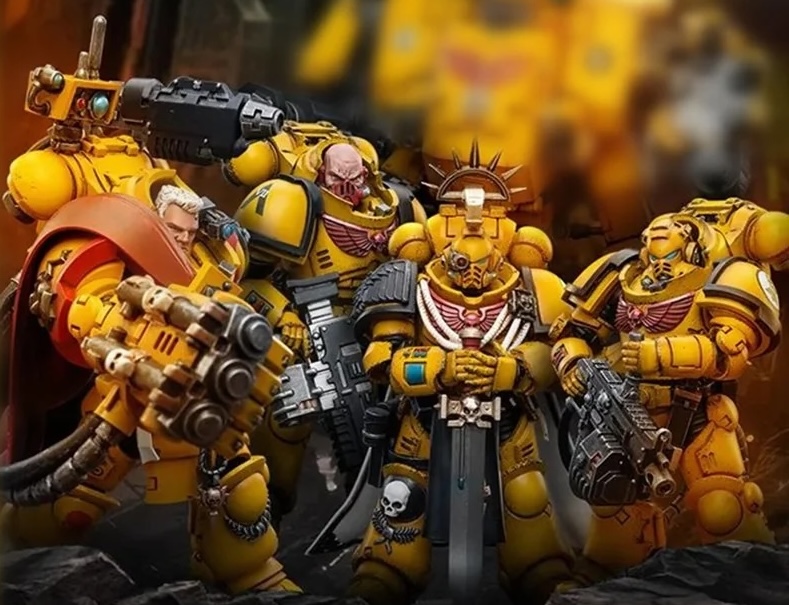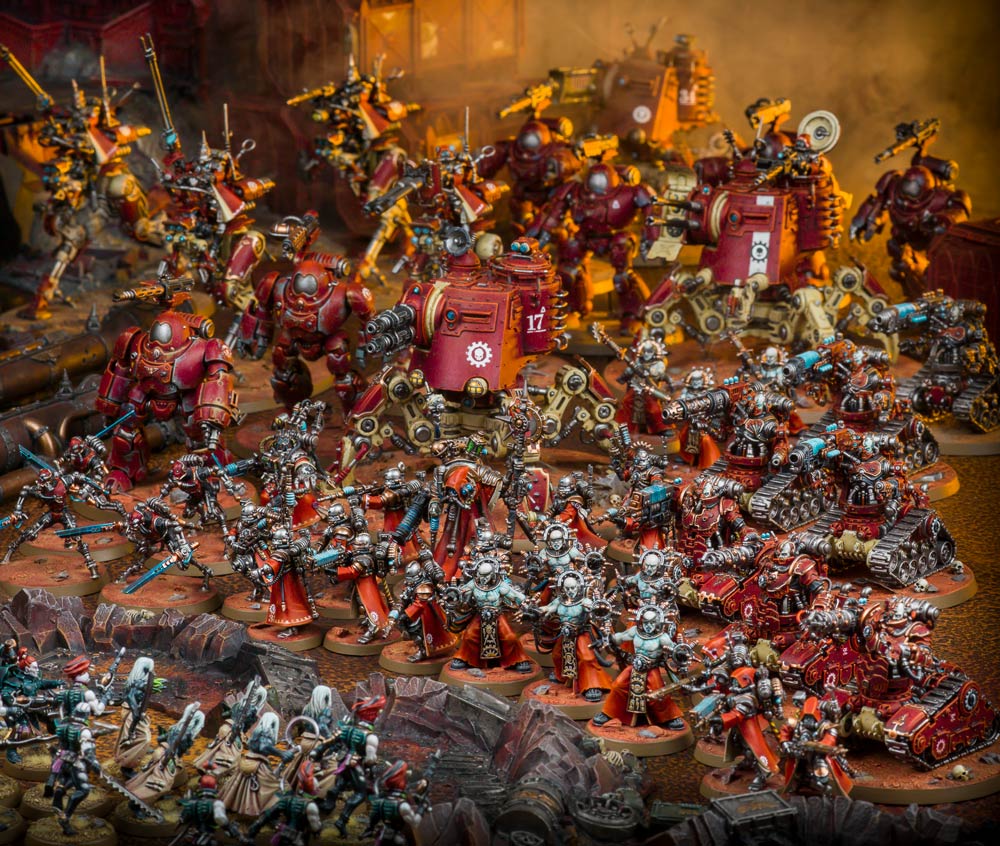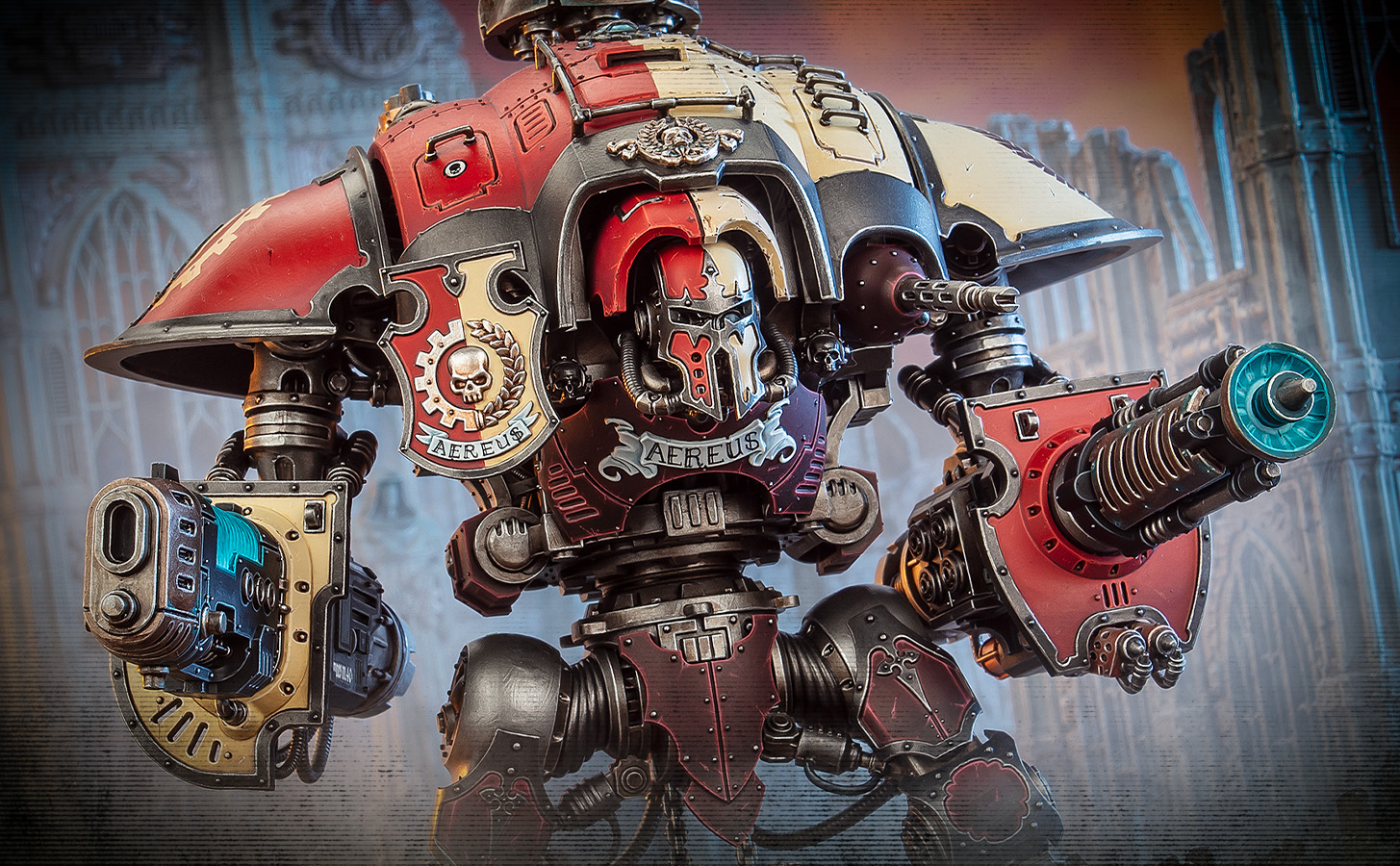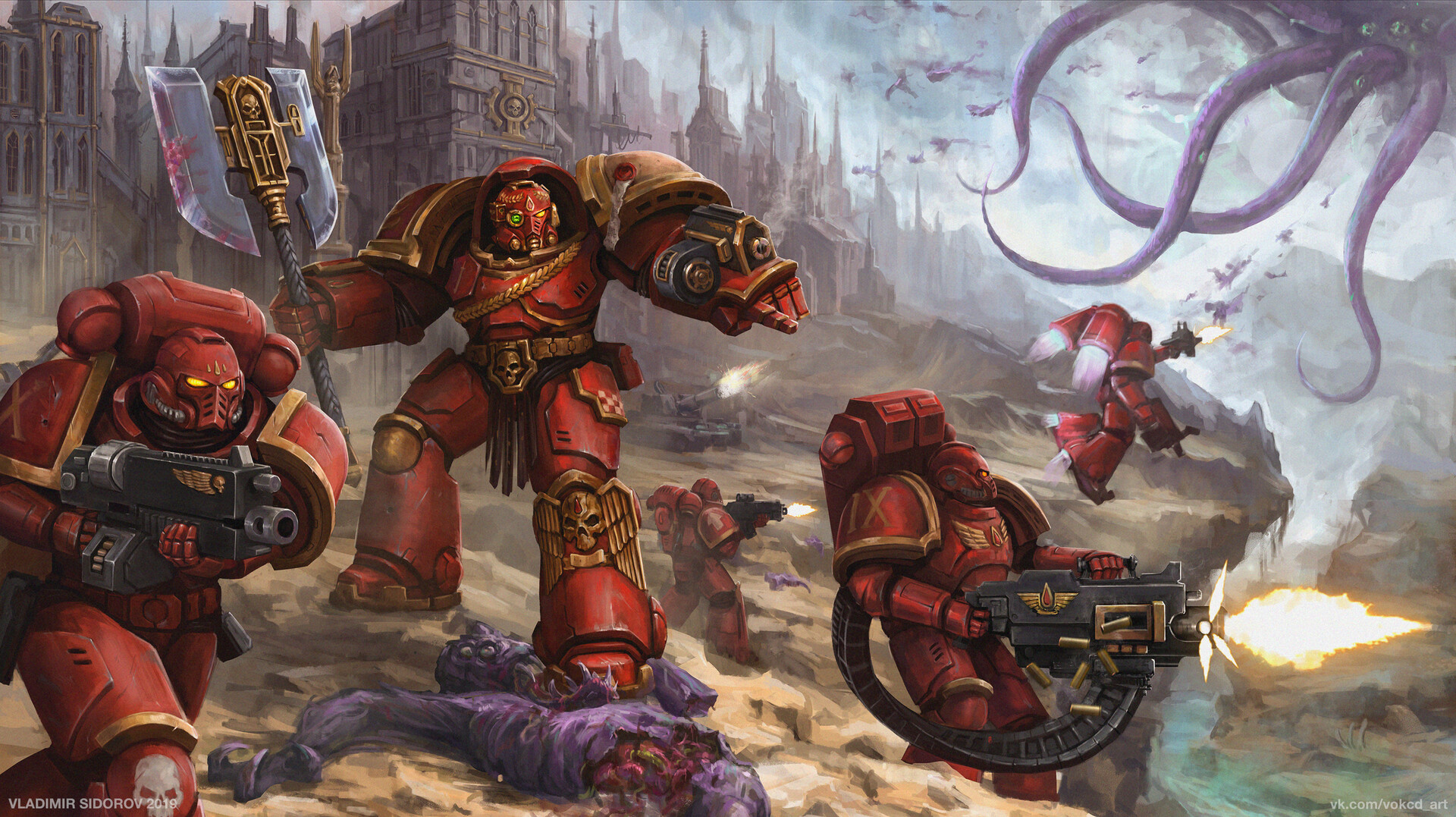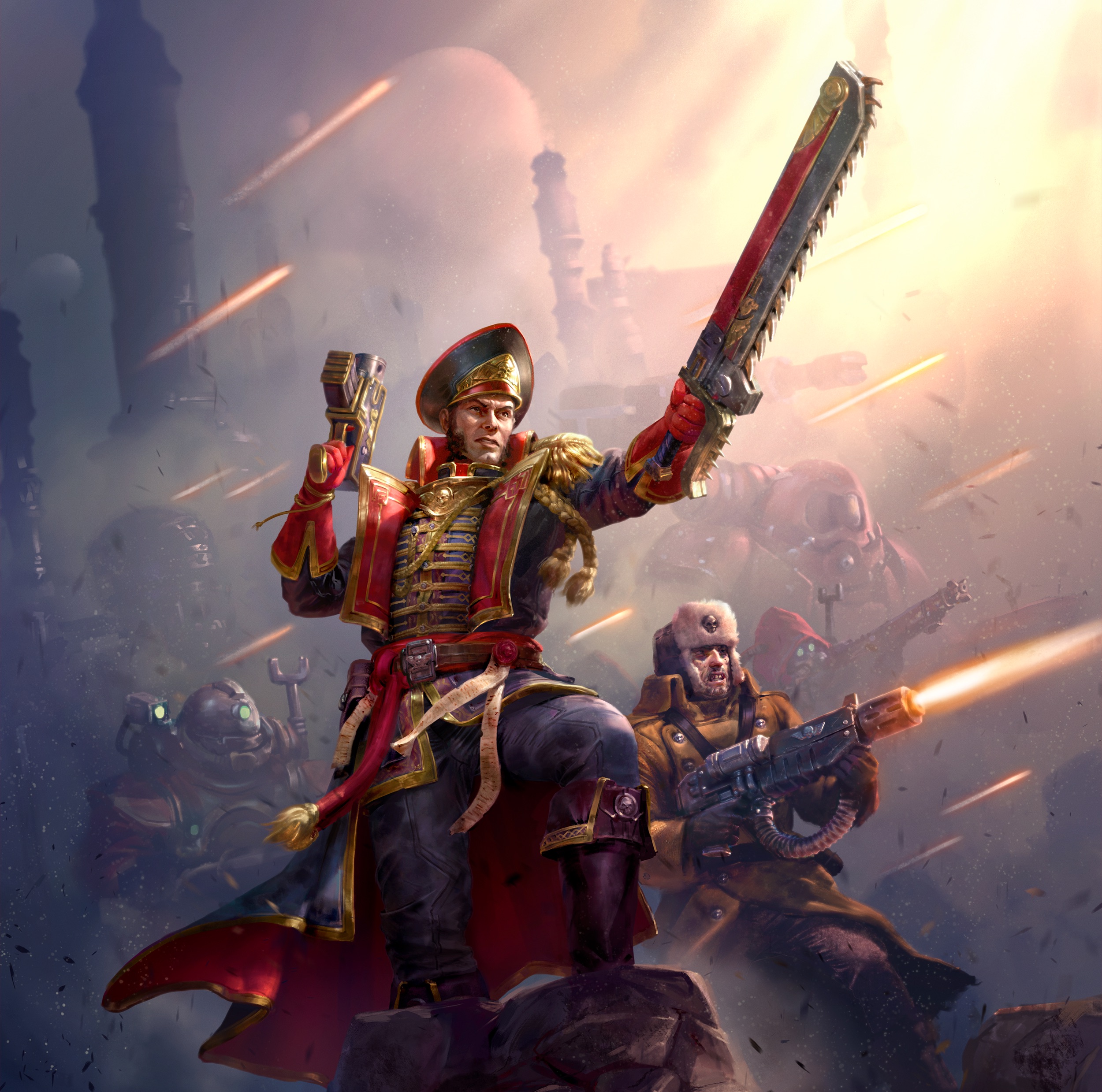The soldiers of the Astra Militarum stand ready amidst the ruins of war, forming the Imperium’s shield against innumerable enemies. The Astra Militarum, or Imperial Guard, is the vast primary fighting force of the Imperium of Man in Warhammer 40K. It deploys literally uncountable numbers of human soldiers across the galaxy, supported by tanks, artillery, and aircraft, to defend mankind’s worlds. Despite lacking the superhuman abilities of the Space Marines, the Imperial Guard’s sheer scale and unyielding determination make it the backbone of the Imperial war machine. In the grim darkness of the far future, these ordinary men and women fight and die in droves so that humanity might endure.
Origins and Role in the Imperium
The Astra Militarum traces its origins to the ancient Imperial Army of the Great Crusade era. After the Horus Heresy (the galaxy-wide civil war that nearly toppled the Imperium), the Imperial Army was split to prevent any one commander from wielding too much power. Its naval arm became the Imperial Navy, while the ground forces were reorganized into the Imperial Guard (officially the Astra Militarum in High Gothic). From this reformation onward, the Guard has served as the Imperium’s indomitable bulk army, answerable to the Departmento Munitorum and High Lords of Terra rather than the Space Marine Legions.
Unmatched in scale, the Astra Militarum is the largest coherent fighting force in the galaxy. There are billions of Guardsmen divided into millions of regiments, drawn from every habitable world of the Imperium. Even the Imperium’s administrators cannot precisely tally its size – new recruits number in the trillions each year, and casualty lists reach millions in a single day. It’s said that if the entire Imperial Guard marched in a single column, it would stretch from Holy Terra to the war-torn planet Armageddon. This immense manpower is the Guard’s greatest weapon. In any war zone, they can deploy endless waves of troops until the enemy is overwhelmed by attrition and sheer numbers. Supported by legions of tanks and colossal artillery barrages, the Guard grinds down foes in a brutal war of numbers and firepower. For this reason they are often called the “Hammer of the Emperor,” a blunt force instrument of devastating strength (as opposed to the elite Space Marines, who are the Emperor’s precise “scalpel”).
As the first line of defense for human worlds, the Astra Militarum’s role in the Imperium is utterly crucial. They fight on every front – if a planet’s local militia (PDF) fails, it’s the Guard that is called in next. Without the Imperial Guard, the Imperium would simply be overrun by myriad xenos, heretics, and horrors lurking in the galaxy. Though a single Guardsman is only a normal human with a lasgun, the collective courage and sacrifice of these countless individuals holds the Imperium together. Every day, anonymous Guardsmen’s actions decide the fate of worlds. They bleed and die so that the Emperor’s realm does not perish. In short, the Astra Militarum is the indispensable backbone of Imperial defense – the common human soldiers who, through faith and fire, stand against the darkness when all others fall.
Recruitment and Training
Where do the billions of Guardsmen come from? The answer is: from nearly every world in the Imperium. The Imperium raises new Guard regiments through a system of tithes. Each Imperial planet is obligated to provide a portion of its population for service. Typically, a world must send at least 10% of its military-age population (often far more in wartime) to the Astra Militarum. For example, a hive world teeming with people might be ordered to raise and ship out a hundred million soldiers (plus millions of vehicles) in a single tithe, barely a fraction of its total populace. In times of crisis, these demands only increase – entire hive city districts may be emptied of able-bodied citizens to fill the Guard’s ranks. From the dank underhives of industrial worlds to the toxic jungles of death worlds, billions are conscripted or volunteered into service each year.
The backgrounds of Guardsmen are as varied as the Imperium’s worlds. A newly raised regiment might include brutal gang fighters from a hive-city, nomadic horsemen from a steppe world, primitive tribesmen from a feral world, or hardened survivors from a death world. Many come from planets where every day is a fight to survive, which breeds superb soldiers. (On Catachan, for instance, children learn to shoot before they can even walk in order to survive that lethal jungle planet.) Such recruits already know how to fight, but the Imperium still rigorously trains and indoctrinates them to become proper Imperial Guardsmen. During the long warp-voyage from their homeworld to a war zone, new troops undergo intensive drill and political/religious indoctrination. They are trained to use standard weapons and wargear, taught to obey orders unquestioningly, and psychologically conditioned to withstand the terror of combat on alien battlefields. This training is harsh – often brutal enough to kill the weak – but it forges disparate recruits into cohesive units “worthy of the Astra Militarum”. By the time a regiment reaches the front, its soldiers (whether once hive gangers or tribal hunters) are expected to function as disciplined Imperial Guardsmen, fully indoctrinated to fight and die for the God-Emperor.
Officers and specialists also undergo particular preparation. Most regiment’s junior officers come from the same world and culture as their troops, often local nobility or the toughest veterans of the planet’s PDF, to ensure the men will follow them. Meanwhile, elite troops are trained in specialized schools – for example, the Schola Progenium produces Storm Troopers (Tempestus Scions) and Commissars, indoctrinated from youth to be the Emperor’s uncompromising instruments. Regardless of origin, all Guardsmen are ultimately subject to the same unforgiving regimen. Before seeing battle, a typical unit will spend months in combat drills and live-fire exercises. They practice everything from combined-arms tactics to basic survival in environments utterly unlike their home. (It’s noted that a hive-city dweller who’s never seen an open sky must be mentally prepared to fight across an open alien desert, and vice versa for an agri-world farmer suddenly fighting in a hive-city ruin.) By the end of training, those troopers who haven’t washed out (or died) are as ready as humanly possible to face the nightmare enemies of the Imperium.
Once deployed, a regiment usually stays in the fight indefinitely. A founding will be shipped off to one war, then another, rarely ever returning home. Guardsmen often spend their entire lives campaigning on distant worlds. As casualties mount, regiments may be reinforced by folding multiple depleted units together, or by recruiting from whatever planet they’re on. Over time, most regiments are simply ground down to extinction – far more often dying to the last soldier than ever being recalled home to retire. It is a harsh system, but through constant influx of new recruits the Astra Militarum keeps its ranks filled. There is always another war and always a new generation of Guardsmen to wage it.
Famous Regiments of the Imperium
Over ten thousand years of war, certain Astra Militarum regiments have become legendary for their exploits. Each regiment reflects the culture of its home world, giving the Imperial Guard a colorful variety of uniforms, tactics, and traditions. Below are a few of the most renowned regiments in Imperial service:
• Cadian Shock Troops: Hailing from the fortress world of Cadia, the Cadian regiments were long regarded as the Imperium’s finest line infantry. Positioned at the edge of the Eye of Terror, Cadia was a strategic bulwark against Chaos incursions for millennia – every man, woman, and child on Cadia grew up under arms, drilling with lasguns from childhood. Cadians are disciplined, dutiful, and superb marksmen. Although Cadia was ultimately destroyed during Abaddon’s 13th Black Crusade, its surviving soldiers fight on with unwavering resolve. Scattered Cadian Shock Troops now continue the fight across the galaxy, embodying the defiant motto “Cadia Stands” – as long as even one Cadian lives and fights for the Emperor, Cadia’s spirit endures. Their purple-eyed veterans and distinctive light-green armor remain a common sight on battlefields everywhere, and many other worlds model their own guard forces after the legendary Cadians.
• Catachan Jungle Fighters: The Catachans come from one of the deadliest death worlds in the Imperium – a planet where every animal is a predator and every plant is poisonous】. Life expectancy on Catachan is abysmally low; only the hardiest and most skilled survive to adulthood. Those who do are incredibly tough, instinctive warriors. Catachan Jungle Fighter regiments are famous for their **Vietnam War-style guerrilla expertise: they excel at jungle warfare, ambushes, booby traps, and close combat. Muscular, bandana-wearing and wielding huge knives, they look like wild men, and indeed their attitude is often brash and aggressive. Yet this is born from true confidence – Catachans often joke that no war zone could be worse than home. Even the most suicidal missions are “nothing compared to spending a day in the Catachan jungle,” they say. Their gung-ho enthusiasm can seem like bravado, but it’s backed up by phenomenal skills. In battle, Catachans are utterly fearless and tenacious, making them some of the most valorous soldiers of the Guard. They are rightly respected for their ability to operate in hostile environments that would kill other regiments outright.
• Death Korps of Krieg: The Death Korps are Imperial Guard regiments from the post-apocalyptic world of Krieg. Notoriously grim and fatalistic, these troops have a singular drive to atone for their planet’s past rebellion by offering up their lives to the Emperor. Krieg was devastated by nuclear civil war, and its survivors endure a bleak, irradiated existence – a background that produces soldiers who are utterly unfazed by carnage. Death Korps Guardsmen wear heavy greatcoats and gas masks and fight with a dour World War I-style demeanor. They specialize in trench warfare, sieges, and wars of attrition. In fact, Death Korps units will gladly endure horrific losses to accomplish their objectives, viewing death in battle as a noble sacrifice. They often volunteer for the most hellish war zones and grind the enemy down through relentless, attrition-centric tactics. Enemy fortifications that would take other forces months to reduce, the Krieg regiments will storm in weeks at the cost of unimaginable casualties. Their macabre bravery earned them a fearful reputation – to face the Death Korps is to face soldiers who absolutely do not fear death and will never retreat while still drawing breath.
• Valhallan Ice Warriors: The Valhallan regiments hail from the frigid ice world of Valhalla. They are famous across the Imperium for their unshakeable tenacity in defense. Valhallan Ice Warriors will hold the line against hopeless odds, enduring appalling casualties without breaking. This stoic mindset was forged in their planet’s history – Valhalla was once a paradise world until a comet impact knocked it into an ice age, after which the Valhallans not only survived underground but also fought off a massive Ork invasion. Thus, they have a particular hatred of Orks and often get deployed to fight greenskin incursions. In battle Valhallans are experts at cold-weather warfare and protracted sieges. They famously never retreat or surrender, whether they’re dug into fortress snow bunkers or launching human-wave attacks with fixed bayonets. Their fur-lined greatcoats and antiquated Russian-esque uniforms belie an iron discipline. When attacking, Valhallans favor massed artillery barrages followed by waves of infantry – when defending, they stand their ground to the last, earning them a legend for stubborn resilience.
• Tallarn Desert Raiders: The Tallarn regiments come from Tallarn, a once-beautiful world turned into a radioactive desert during the Horus Heresy. Tallarn’s people adapted by developing highly mobile warfare to survive the endless dunes. Thus, the Tallarn Desert Raiders are masters of swift guerrilla tactics and mechanized hit-and-run warfare. They excel at fighting in arid, open environments, using speed and stealth as their primary weapons. Tallarn units typically deploy lots of camouflaged vehicles – such as swift Sentinel walkers, armored transports, and tanks – to outmaneuver the enemy. They are noted marksmen (favoring long-las rifles and sniper attacks) and often employ mounted cavalry or bikes to scout and harass. Historically, Tallarn forces gained renown by defeating a massive Chaos tank army on their homeworld through superior maneuver and guerrilla strategy. To this day, Tallarn crews are counted among the Imperium’s finest tank operators, and Tallarn regiments heavily use armored companies and rapid flanking attacks. In the scorching war zones of deserts and ash wastes, the Tallarn Raiders are in their element – striking hard and then vanishing like ghosts in the sand.
• Armageddon Steel Legion: Raised on the industrial Hive World of Armageddon, the Steel Legion is famous for its wars against the Orks. Armageddon has been the site of three titanic wars (the First, Second, and Third Wars for Armageddon), including two planet-wide invasions by the Ork warlord Ghazghkull Thraka. As a result, the Steel Legion regiments are extremely experienced in Ork-fighting and urban warfare. They favor a mechanized doctrine: Armageddon’s factories produce a huge number of Chimera APCs, so its regiments mount their infantry in Chimeras and field many armored companies. Steel Legion troops wear distinctive long coats and gas masks suited for Armageddon’s polluted atmosphere. On the battlefield, they excel at mobile defense and attrition – using waves of mechanized infantry supported by battle tanks and artillery to blunt Ork assaults in the toxic ash wastes around hive cities. Their countless clashes with the Orks have made them experts at dealing with greenskin tactics. Indeed, the armies of Armageddon are so adept at Ork warfare that commanders across the galaxy request Steel Legion units when facing a major WAAAGH! These regiments epitomize the dogged, mechanized strength of hive-world Guardsmen fighting in ruinous industrial battlefields.
• Mordian Iron Guard: The Mordian Iron Guard are the disciplined soldiers from the world of Mordian – a tidally-locked, perpetually dark hive city planet known for its strict societal order. Mordian regiments are renowned for their parade-ground discipline and iron resolve. They fight in close-order drill formations, often dressed in crisp blue uniforms with polished brass, presenting an almost ceremonial appearance. But one should never mistake them for mere show troops: “These men are steel-eyed, cold-blooded killers,” as an Imperial commander once said, “I’d as soon have a platoon of them as a company of any other”. Mordian Iron Guard will hold their lines in perfect formation even under horrific fire. They obey orders to the letter, firing volley after volley with flawless precision until either the enemy is vanquished or they themselves lie dead. Their home planet’s harsh, overpopulated conditions (where resources are scarce and chaos is always one misstep away) bred a culture of absolute obedience. This translates to the battlefield, where Mordian units have virtually unbreakable morale. In defense they are immovable, and in assaults they advance relentlessly in lockstep. Their extreme discipline and drill make them among the most dependable troops in the entire Imperium – you can trust a Mordian Guard unit never to panic or falter, no matter how desperate the situation.
(Many other regiments could be highlighted – the Vostroyan Firstborn with their archaic weapons and vow to send each family’s firstborn son to the Guard, the Attilan Rough Riders who thunder into battle on horseback with explosive lances, the drop troopers of Elysians, the tunnel-fighting specialists of Armageddon’s Steel Legion, and more. The above are but a sampling of the diverse armies that make up the Astra Militarum’s endless ranks.)
Tactics and Warfare
On the battlefield, the Astra Militarum prosecutes war with a philosophy of overwhelming force. Subtlety is rarely their forte – they win by bringing to bear far more firepower and soldiers than the enemy can handle. A common Imperial Guard battle plan employs combined-arms warfare on a massive scale. First, enemy positions are pounded with colossal artillery barrages and orbital bombardments. Then, waves of infantry – tens of thousands of bodies – advance with tanks rolling alongside or behind them for support. The Guard’s primary tactic is literally to overwhelm the foe with endless numbers, while simultaneously pulverizing them with heavy guns. Lumbering Leman Russ battle tanks and other armored vehicles form the backbone of many assaults, acting as moving fortresses for the Guardsmen. Meanwhile, mortar and Basilisk artillery batteries (nicknamed the “Emperor’s Sword”) soften up defenses from afar. The Imperial Guard doesn’t shy away from high casualties if it gains victory; in fact, it is said the Guard will expend five thousand men to achieve what a Space Marine company could with five hundred. Human life is the Emperor’s currency, and the Guard spends it liberally. “It does not matter how many casualties it takes to win a battle,” goes an old Imperial saying. “The Imperial Guard will devote divisions of men to seize a minor hill, where a Space Marine strike force might suffice to take an entire city.” In short, attrition warfare is the Guard’s grim art – they will batter the enemy with sheer volume of fire and soldiers until the foe crumbles.
Within that broad strategy, of course, the Guard employs all manner of specific tactics depending on regiment type and commander. They are not merely a mindless horde; they coordinate infantry with tank units, mobile artillery, air support from the Imperial Navy, and even elite operatives. Imperial Guard armies often field special forces like the elite Kasrkin or Tempestus Scions for surgical strikes, while the rank-and-file tie down the enemy in pitched battle. They make extensive use of combined arms – for example, infantry platoons will be backed by attached heavy weapon squads or a squadron of tanks in support. In defensive fights, Guardsmen entrench and call in massive off-map artillery or aerospace strikes. In offenses, they might use armored spearheads to punch through, followed by infantry flood tactics to secure ground. There is tremendous strategic flexibility in an army that might number a million soldiers – entire regiments can be sacrificed as decoys while others encircle the flanks. Some Guard commanders are brilliant strategists, others are blunt but effective, and a few are incompetents who waste lives needlessly. But ultimately, the Guard’s approach to warfare can be summed up as “quantity has a quality all its own.” Given enough troops, enough tanks, and enough guns, they believe any foe can be ground into dust. This approach has won many wars for the Imperium, at a cost of oceans of human blood.
Life in the Guard
A Commissar of the Death Korps of Krieg enforces iron discipline in the ranks of the Guard. Life as a Guardsman is notoriously brutal and short. Recruits are shipped off from their home world to fight on distant battlefronts they often know nothing about. Once deployed, they face nightmarish enemies – from towering Ork warlords to Tyranid bio-horrors or Chaos demons – armed with little more than a lasgun, a bayonet, and their faith. Death is a near-certain fate for the average Guardsman. A common (and accurate) saying is that most Guardsmen will not live to see their second year of service, nor ever return to their homeworld. The scale of casualties in Imperial Guard campaigns is staggering: entire regiments (tens of thousands of soldiers) can be wiped out in a single horrific engagement. Those few who survive battle after battle become scarred veterans, but even they know that eventually their luck will run out. Very few Guardsmen ever “retire” – their units are almost always destroyed to the last man long before any mustering-out can occur. This grim reality produces a fatalistic outlook in many troops. They fight not expecting to live, but determined to sell their lives dearly for the Emperor.
Day-to-day existence in the Guard is an exercise in hardship. Marching through frozen mud fields or baking deserts, sleeping in foxholes under alien skies, subsisting on corpse-starch rations and recaf, a guardsman’s comfort level is nil. Discipline is harshly enforced to keep the vast armies in line. Each regiment has Commissars attached – political officers whose job is to maintain morale and obedience through fear. These black-coated figures will not hesitate to execute any soldier (even a lieutenant or colonel) who shows cowardice, disobeys orders, or even speaks of retreat. Fleeing in the face of the enemy is a capital offense in the Imperial Guard. Many Guardsmen are kept in the fight only by the knowledge that a Commissar’s bolt pistol behind them is a greater threat than whatever xenos monstrosity lies ahead. The command structure is equally unforgiving: officers may order suicidal assaults without a second thought, valuing objectives over lives. Punishments for insubordination or failure are brutal – flogging, starvation, or summary execution. In some campaigns, attrition from firing squads and penal duties can be nearly as dangerous as enemy fire. Camaraderie and faith are thus vital to Guardsmen. They cling to their squadmates and to the Imperial Creed preached by regimental chaplains. The uplifting words of a Ministorum priest or the inspirational speech of a beloved commander can stiffen their resolve amid despair. Ultimately, what keeps a Guardsman going is often a mix of Imperial indoctrination, unit pride, and the simple will to protect their fellow soldiers in the line. They know the Emperor is watching, and to falter would be to betray all of humanity.
Yet, amidst all these horrors, there is a true heroism to the Imperial Guard. These are normal men and women – factory workers, hive city gangers, farmers, tribal hunters – who stand against the worst nightmares of the galaxy with nothing but their weapon, faith, and courage. They witness the deaths of friends by the dozens, fight in conditions that defy sanity, and still they press on. The morale of the Guard is a study in contrasts: on one hand, terror and despair are constant companions; on the other, there are countless tales of astonishing bravery and self-sacrifice. Guardsmen often perform acts of valor knowing full well they won’t survive. They’ll throw themselves on a grenade to save squadmates, hold a chokepoint alone against alien horrors, or charge a Heretic tank with only a melta-bomb. The Imperium celebrates such martyrs in its propaganda, turning fallen Guardsmen into legends to inspire new recruits. And indeed, despite being treated as expendable cogs, the average Guardsman takes pride in their duty. They know that without their sacrifice, mankind would surely fall. As one veteran declared to fresh recruits: “When you fight for the Emperor, you can die with your head held high, knowing your life was not wasted.” Every victory of the Guard, no matter how pyrrhic, reinforces this belief. The courage of ordinary Guardsmen is the true strength of the Astra Militarum. It is their blood that holds the Imperium’s line. In the end, for all the high-tech tanks and vast strategies, it is the simple lasgun-wielding infantryman – standing firm in the face of horror – who proves decisive. The life of a Guardsman is hard and likely to be short, but it can embody the purest devotion and heroism in service to humanity’s survival.
The Astra Militarum in the Modern Era
The current era of Warhammer 40K (the dawn of the 42nd Millennium) is known as the Era Indomitus, and it has tested the Astra Militarum like never before. Toward the end of M41, a series of catastrophic events plunged the galaxy into new turmoil. Foremost among these was the 13th Black Crusade and the Fall of Cadia. The fortress world of Cadia – linchpin of Imperial defenses in the Cadian Gate – was attacked by the full might of Abaddon the Despoiler. The Imperial Guard (alongside Space Marines and other forces) fought ferociously to hold Cadia, but after a titanic struggle, the planet was destroyed. The fall of Cadia was a pyrrhic victory for the Imperium: of nearly a billion souls who stood in Cadia’s defense, only about three million managed to evacuate before the planet broke apart. The overwhelming majority of the Cadian regiments died on their home soil, and their famed leader Lord Castellan Creed went missing in action. This was a devastating blow – the loss of an entire world’s worth of elite troops in one campaign. But worse was yet to come. In the wake of Cadia’s fall, the galaxy itself was rent asunder by a colossal warp storm known as the Cicatrix Maledictum (the “Great Rift”). This Warp rift tore the galaxy in half, creating a permanent monstrous storm across the stars. In an instant, innumerable Imperial forces were cut off or annihilated. Entire battlefleets translating through the Warp were lost or stranded. Countless newly-raised regiments preparing to ship out, troop transports en route to war zones, and stockpiles of weapons on Forge Worlds were swallowed by the screaming madness of the Warp. Vast swathes of the Imperium went dark, cut off from Terra – this became known as Imperium Nihilus, the dark half of the galaxy where the Astronomican’s light could not reach. In these regions, many Guard armies suddenly found themselves isolated, without reinforcement or resupply, facing renewed assaults by aliens and Chaos with no hope of relief.
Amid this galactic disaster, Roboute Guilliman (Primarch of the Ultramarines, newly resurrected) took command as Imperial Regent and launched the Indomitus Crusade. This was a massive, multifleet counter-offensive aimed at reuniting the sundered Imperium and pushing back the tides of Chaos. For the Astra Militarum, the Indomitus Crusade brought both great opportunity and great strain. Guilliman and his commanders demanded huge numbers of Guard regiments to spearhead and garrison the crusade’s battlefronts. Even as worlds were losing contact and crying out for aid everywhere, tithes were raised to unprecedented levels. The Departmento Munitorum stripped already war-torn sectors of every available soldier to fuel the crusade. Entire hive cities were emptied in vicious conscription drives to raise fresh regiments overnight. Forge worlds worked overtime to send tanks and munitions to the front, while basic food and supplies grew scarce on many planets. The Astra Militarum was effectively stretched to the breaking point – every Militarum Regimentum (the total forces of a given world) was squeezed for additional troops, leaving many home fronts dangerously undermanned. Despite these hardships, the Imperial Guard performed with astounding valor in the Indomitus Crusade. As the crusade fleets burned across war zones, the Guard made up the vast majority of each task force’s ground armies. In battle after battle, it was Guardsmen – not just Space Marines – who fought in the trenches, secured the city ruins, and held the line against counterattacks. The Indomitus fleets might have been led by the Adeptus Astartes, but every victory was followed by the Guard digging in to hold newly liberated worlds. In fact, Guilliman often demanded that newly saved planets immediately raise extra regiments to join the fighting, which the Imperial Guard dutifully absorbed to replace their losses. Thus, the Guard grew into an ever-swelling tide moving with the Crusade, a living wave of humanity reclaiming the Emperor’s realm one system at a time.
The pressures on the Guard during this era were immense. The Great Rift’s chaos meant that communication and travel were erratic – some regiments went without orders or supplies for years, fighting on with scavenged equipment and unshakeable faith. In the Imperium Nihilus (the cut-off half), many Guard units became the last bulwark on besieged worlds, improvising defenses and holding out alone against endless enemies. In the Imperium Sanctus (the half still directly connected to Terra), the Indomitus Crusade brought some relief and reinforcement, but also constantly pulled veteran units away to distant fronts. Heroism flourished amid the desperation. Surviving Cadian units, for example, became fleet-based and continued to fight with a vengeance – the saying “Cadia Stands!” became a rallying cry for all Guardsmen facing impossible odds. On world after world, the Guard proved its worth by sheer resilience. Even when Astropathic cries for aid went unanswered in the darkness of the Noctis Aeterna, Guardsmen held their posts and refused to yield. The toll, however, was enormous: whole armies were lost to the Warp or consumed in unwinnable battles. The Departmento Munitorum struggled to keep track of which units were alive or dead across the fragmented war zones.
As of now, years into the Indomitus era, the Astra Militarum remains indispensable in all major conflicts. Guilliman’s crusade has split into smaller contingents and ongoing theaters of war, but the Guard is still there in force. From the haunted reaches of Imperium Nihilus to the embattled star sectors of Ultramar, Guardsmen can be found fighting and dying wherever the Imperium faces threats. They are holding newfound footholds on Chaos-corrupted worlds, re-garrisoning forge worlds and hive planets that survived the Rift’s opening, and accompanying the newer Space Marine Chapters (the Primaris Marines) in continued offensives. Notably, some high-ranking Guard officers have risen to command entire Indomitus Crusade battlegroups – for instance, a Lord Solar named(Fleetmaster) Cassandra VanLeskus of the Vodian regiments was given charge of a crusade fleet, showing that even in this age a capable Guard commander can coordinate Astartes, Navy, and Mechanicus forces at the highest levels. The Guard’s adaptability is being tested to its limits: they fight Necron dynasties awakening on one front, Drukhari raiders exploiting the chaos on another, all while the perennial foes of Orks, Tyranids, and Chaos Cultists continue to strike everywhere. Through it all, the men and women of the Astra Militarum persevere.
In the grim darkness of the far future, there is only war – and the Astra Militarum is humanity’s inexhaustible army for waging it. The legacy of the Imperial Guard is one of sacrifice and courage on an astronomical scale. Now, in this desperate modern era, that legacy continues stronger than ever. For every world that falls to darkness, another is saved by the blood of countless Guardsmen. Where the Emperor’s Angels of Death (the Space Marines) are few, the Guardsmen are numberless – and it is they who must hold the thin line between civilization and annihilation. Facing new nightmares unleashed by the Great Rift, the soldiers of the Astra Militarum fight on with lasgun and bayonet, with faith and ferocity. Their story is one of endless war and unimaginable loss, but also of hope – the simple, defiant hope that mankind’s sheer determination can endure any storm. In the ashes of Armageddon, in the jungles of Octarius, across the stars of the Indomitus Crusade, the Imperial Guard stands resolute. With grit, guts, and a prayer to the God-Emperor, the Astra Militarum will battle on, unto the end of all things, so that humanity shall not perish from the galaxy. Glory to the First Rank, fire! Glory to the Astra Militarum!
